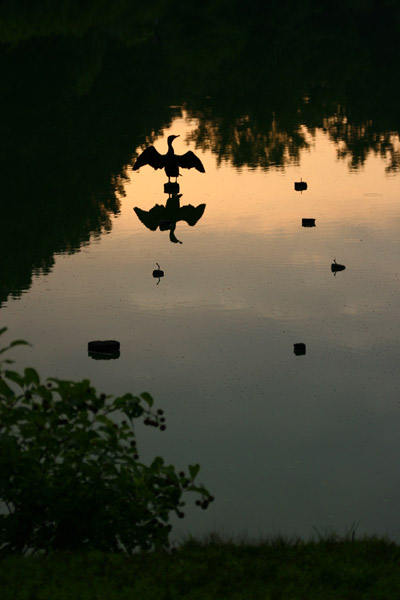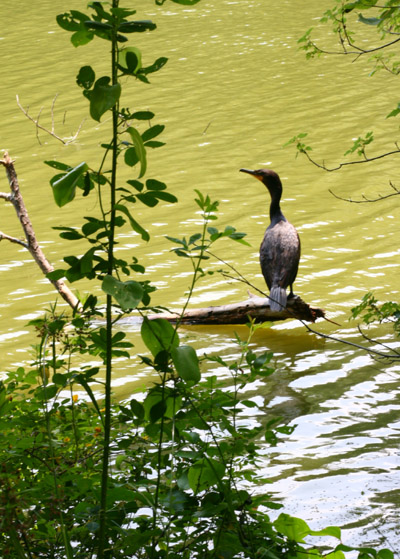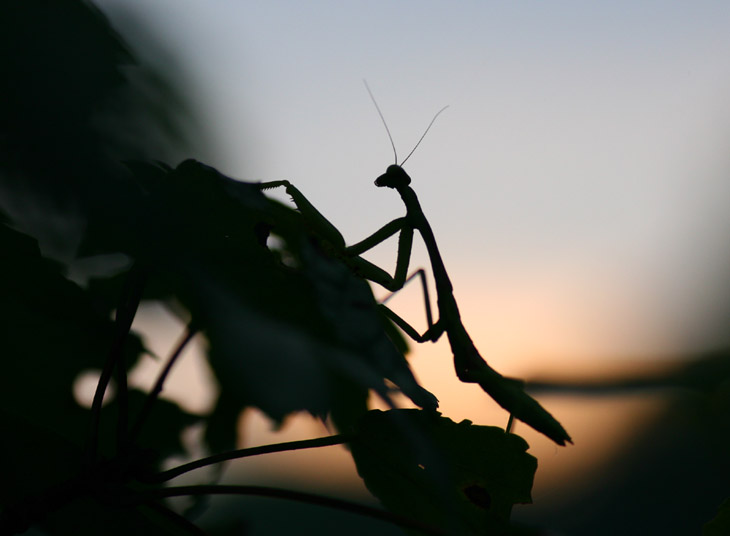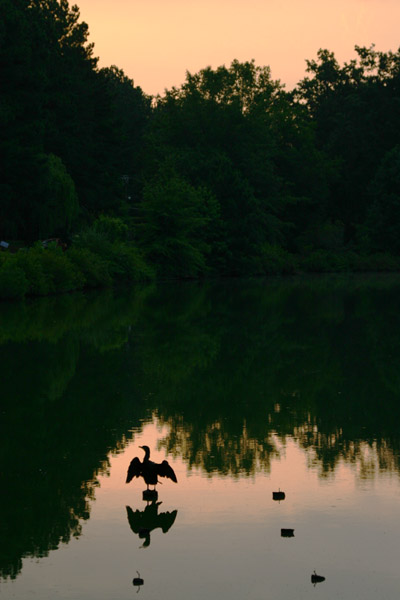 Most of the time recently, the skies are so clear at sunrise that they’re boring, lacking in rich colors and clouds to throw some textures into the mix. But this morning looked like it was going to be different, so I trotted over to the pond to see what would develop as the sun came into view. While the sky did not quite produce the qualities that I was hoping for, I received the cooperation of a double-crested cormorant (Phalacrocorax auritus) which has taken up residence in the pond now, sharing it with a great blue heron or two, a green heron, and a cluster of Canada geese.
Most of the time recently, the skies are so clear at sunrise that they’re boring, lacking in rich colors and clouds to throw some textures into the mix. But this morning looked like it was going to be different, so I trotted over to the pond to see what would develop as the sun came into view. While the sky did not quite produce the qualities that I was hoping for, I received the cooperation of a double-crested cormorant (Phalacrocorax auritus) which has taken up residence in the pond now, sharing it with a great blue heron or two, a green heron, and a cluster of Canada geese.
We don’t see cormorants around here too often – they usually like larger bodies of water, and tend to flock. I was used to seeing them all the time in Florida (along with the occasional anhinga,) but have spotted very few since I left there. This one is demonstrating a typical behavior of both cormorants and anhingas, as well as vultures, which is posing ‘spread-eagle’ to dry out the wings. For the waterfowl, this is usually because they hunt fully submerged, but for the vultures it is more likely to dissipate overnight dew, and potentially to warm up after cold nights. Such a thing isn’t necessary right now, since the overnight temps are barely any lower than the daytime.
The dark geometric shapes in the water are the pilings from an old dock, providing a handy platform for the cormorant (at least, the ones without nails still sticking out.) And yes, I purposefully positioned myself so the bird fell into the gap in the reflection of the background trees, creating a nice natural frame, because that’s what you do. Or should, anyway. As can be seen, only a small band of the sky was producing any color, so that’s what I aimed for; make the photo, rather than taking it, you know?
 A few days back when I’d first spotted the cormorant, it was sitting quite close to shore on a log, and wasn’t terribly concerned with my presence, though it was plainly aware of me and likely would have preferred that I not be around. So far everything I’ve been able to get has been backlit, which is a shame, because cormorants have the most brilliant jade green eyes. It’s curious, actually; most of the raptors have yellow or brown eyes, and for the songbirds brown is the norm. Sandhill cranes have orange eyes, white ibis have blue, wood ducks have red, but cormorants are the only ones with green eyes to my knowledge (which, it must be said, is not comprehensive by any stretch.) If I don’t manage to get any close and well-lit shots showing the eyes soon, I’ll dig out some slides that I have which illustrates the color nicely. In fact, probably much better than the digital camera does – the color register of Fuji Provia and Velvia film beats the hell out of any digital camera or setting that I’ve come across, and if I had the ability to process it at home conveniently, I’d probably be using film more often. As it is, it’s getting difficult to find processing services, and more expensive – at some point I’ll do a post about “convenient mediocrity.”
A few days back when I’d first spotted the cormorant, it was sitting quite close to shore on a log, and wasn’t terribly concerned with my presence, though it was plainly aware of me and likely would have preferred that I not be around. So far everything I’ve been able to get has been backlit, which is a shame, because cormorants have the most brilliant jade green eyes. It’s curious, actually; most of the raptors have yellow or brown eyes, and for the songbirds brown is the norm. Sandhill cranes have orange eyes, white ibis have blue, wood ducks have red, but cormorants are the only ones with green eyes to my knowledge (which, it must be said, is not comprehensive by any stretch.) If I don’t manage to get any close and well-lit shots showing the eyes soon, I’ll dig out some slides that I have which illustrates the color nicely. In fact, probably much better than the digital camera does – the color register of Fuji Provia and Velvia film beats the hell out of any digital camera or setting that I’ve come across, and if I had the ability to process it at home conveniently, I’d probably be using film more often. As it is, it’s getting difficult to find processing services, and more expensive – at some point I’ll do a post about “convenient mediocrity.”
The cormorant wasn’t the only subject matter to be backed by the morning light. As I passed close to a tree, an atypical pattern made be pause and look closely, revealing, yes, another mantis. I checked: contrary to suspicions, it’s the Chinese year of the sheep, but that just goes to show you what they know. I haven’t seen a sheep around here in ages.

I played with using fill-flash to illuminate this side of the mantis as well, but it took some experiments to balance the light levels usefully, and the mantis was much more concerned about my presence than the cormorant, seeking shelter even as I tracked it, so this image ended up being better than those.
 I’ll leave you with another version of the cormorant poses – still trying to decide which one I like the best. This one was tweaked a little to bring the background trees slightly brighter, giving a little more texture to the whole image. I’m wondering if I should have tried using fill-flash for this one as well, to bring out a little detail from the bird rather than rendering it a simple silhouette, but I’m not sure the flash would have produced enough light for that distance. I need to think about these things while I’m shooting, though, and not afterward when I’m looking at the images…
I’ll leave you with another version of the cormorant poses – still trying to decide which one I like the best. This one was tweaked a little to bring the background trees slightly brighter, giving a little more texture to the whole image. I’m wondering if I should have tried using fill-flash for this one as well, to bring out a little detail from the bird rather than rendering it a simple silhouette, but I’m not sure the flash would have produced enough light for that distance. I need to think about these things while I’m shooting, though, and not afterward when I’m looking at the images…




















































